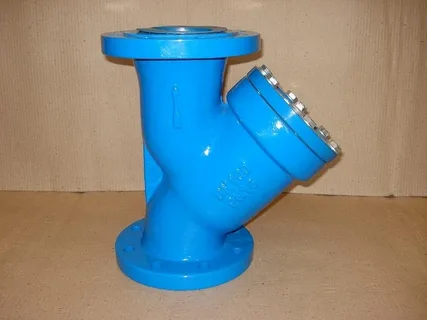In industrial piping systems, the smooth operation of fluid flow is essential to ensure efficiency, reliability, and longevity of equipment. One of the most critical components that helps maintain these parameters is the Y strainer. Despite its small size, the Y strainer plays a significant role in protecting pipelines, pumps, valves, and other related equipment from damage caused by debris and particulates. This article serves as a comprehensive guide to what a Y strainer is, how it works, and why it holds such importance in various industrial applications.
What is a Y Strainer?
A Y strainer is a mechanical device used to filter and remove unwanted solids from a fluid or gas pipeline. Named after its Y-shaped design, the strainer is equipped with a mesh filtering element that captures particles such as rust, dirt, and debris that can compromise the integrity of the system. Y strainers are typically used in systems where small amounts of solids are expected and where regular maintenance and cleaning are feasible.
The Y strainer body is usually made from materials like stainless steel, carbon steel, or bronze, depending on the application’s pressure and temperature requirements. The mesh or perforated element inside the strainer is selected based on the size of the particles to be filtered out.
How a Y Strainer Works
Y strainers operate by forcing the fluid through a mesh filter that traps debris. The clean fluid then continues through the pipeline, while the unwanted particles remain in the strainer’s chamber. The orientation of the Y strainer—usually installed in horizontal or vertical piping—determines how easily the debris can be removed.
When debris accumulates inside the strainer, it can be cleaned manually by removing the cap or cover and flushing out the captured material. Some models are equipped with blow-off valves that allow for easier cleaning without disassembling the system.
Key Components of a Y Strainer
- Body: The outer casing made of durable material to withstand pressure and temperature.
- Screen or Mesh: The filtering component that traps particles.
- Blow-off Port: Allows for flushing debris without opening the strainer.
- Cap or Cover: Provides access to the internal screen for maintenance.
Applications of Y Strainers
Y strainers are used across a wide range of industries due to their versatile filtering capabilities. Common application areas include:
- HVAC Systems: Protecting heating and cooling equipment from clogging.
- Chemical Processing: Filtering chemicals to ensure purity and system safety.
- Water Treatment Plants: Removing particulate matter from water before further treatment.
- Oil and Gas Industry: Protecting sensitive components from damage due to solid contaminants.
- Food and Beverage: Maintaining hygiene and equipment integrity by filtering liquids.
Advantages of Using a Y Strainer
Equipment Protection
One of the primary benefits of using a Y strainer is the protection it offers to downstream equipment. Pumps, valves, meters, and other components are safeguarded against wear and tear caused by solid particles.
Cost-Effective Maintenance
By preventing debris from entering sensitive parts of the system, Y strainers reduce the frequency of breakdowns and extend the life of equipment. This leads to significant cost savings in terms of maintenance and repair.
Operational Efficiency
Cleaner systems run more efficiently. By removing unwanted particles, Y strainers help maintain optimal flow rates and pressure levels, thereby enhancing the overall performance of the system.
Easy Installation and Maintenance
Y strainers are relatively easy to install and maintain. With proper access, the filtering screen can be removed, cleaned, and replaced with minimal disruption to operations.
Limitations of Y Strainers
While Y strainers offer numerous advantages, they are not suitable for all applications. In systems with high levels of solid content, the strainer can clog frequently, requiring more maintenance. In such cases, an automatic self-cleaning strainer or a basket strainer may be more appropriate.
Choosing the Right Y Strainer
When selecting a Y strainer, several factors should be considered:
- Material Compatibility: Ensure the strainer material is compatible with the fluid being processed.
- Mesh Size: Choose a mesh size that effectively filters out the targeted particle size.
- Pressure and Temperature Ratings: Verify that the strainer can withstand the system’s operating conditions.
- Installation Orientation: Ensure the strainer is compatible with the pipeline layout.

Maintenance Tips
To maximize the lifespan and efficiency of a Y strainer, regular maintenance is essential. Here are some tips:
- Routine Inspections: Check for debris accumulation periodically.
- Flush System: Use the blow-off port to flush out minor build-ups.
- Replace Damaged Screens: Worn-out or damaged screens should be replaced immediately.
- Keep Records: Maintain logs of maintenance activities to track performance.
Conclusion
Y strainers may appear to be simple components, but their role in maintaining the integrity and efficiency of fluid systems is indispensable. From protecting critical equipment to enhancing operational efficiency, Y strainers are vital in a multitude of industries. By understanding their function, applications, and maintenance requirements, professionals can make informed decisions that contribute to the longevity and performance of their piping systems. Whether in water treatment, oil refining, or HVAC systems, the Y strainer proves to be a small but powerful ally in fluid management.
For more insightful articles related to this topic, feel free to visit – bdnews55